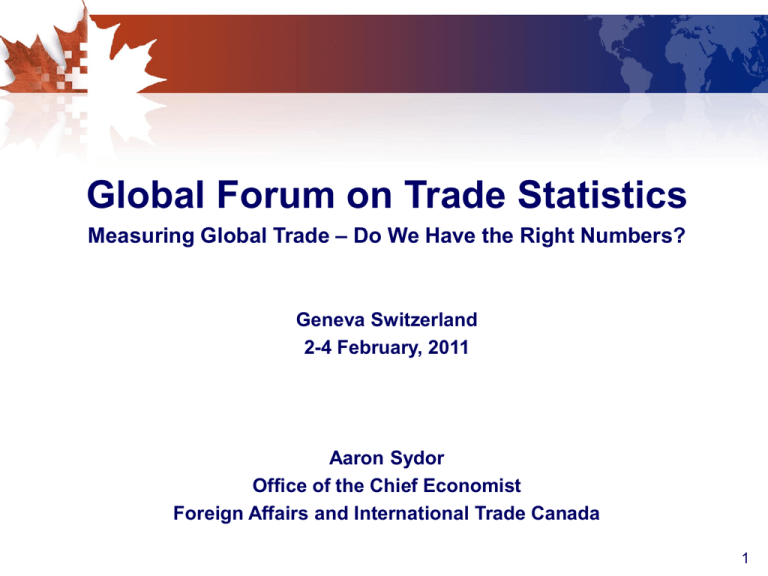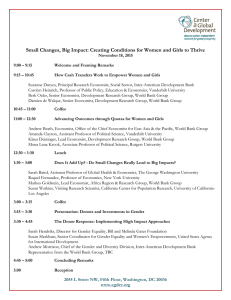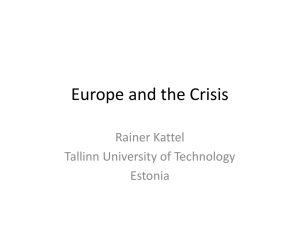Global Forum on Trade Statistics Measuring Global Trade
advertisement

Global Forum on Trade Statistics Measuring Global Trade – Do We Have the Right Numbers? Geneva Switzerland 2-4 February, 2011 Aaron Sydor Office of the Chief Economist Foreign Affairs and International Trade Canada 1 Overview Trends in policy analysis and research…what’s new? • But not all gaps are due to new developments. A user’s perspective of data gaps: • Examples of policy analysis and research; and • Notable data gaps. 2 Trends in Policy Analysis and Research Rising importance of non-OECD countries • Strengthening of North-South and South-South linkages Global value chains • A ‘global commerce’ approach • Increased emphasis on operations of multinationals; offshoring/outsourcing • International fragmentation of all stages of the value chain Firm-level analysis Link between real and financial flows 3 Strategy Example of policy question or analysis Data gaps 4 Goods Trade Share of ‘Others’ in Canadian Goods Trade 16 Percent Non-OECD countries poorly represented in BOP data: – Little price information by product and destination; 14 – BOP categories do not match industries; and, 12 – Terms of trade and prices increasingly important. 10 8 6 Merchandise (customs based data): – Link to tariffs; and, 99 '0 0 '0 1 '0 2 '0 3 '0 4 '0 5 '0 6 '0 7 '0 8 '0 9 97 98 95 96 4 – Access to international data… make Comtrade free! Data: Statistics Canada Source: Office of the Chief Economist, DFAIT 5 FDI and Services Trade Top Ten Destinations for Canadian FDI and Service Exports Destination and source for FDI does not match well with real economic activity: Country Share Country Share U.S. 44.0% U.S. 53.7% – First destination and tax havens; U.K. 11.0% U.K. 6.5% Barbados 6.9% Germany 2.7% – Important for BITs and service delivery; and, Ireland 3.8% France 2.7% – Tracking GVCs. Cayman Islands 3.3% Switzerla nd 2.3% Bermuda 3.1% Bermuda 2.1% France 2.7% Japan 1.8% Australia 2.2% China 1.6% Hungary 2.1% Barbados 1.5% Bahamas 2.0% HK, China 1.4% Data: Statistics Canada; FDI 2009, services 2008. Source: Office of the Chief Economist, DFAIT Services – measurement, lack of detail on modes, lack of country detail, BOP does not match industry categories; – Increasingly important in knowledge-based economies; and, – Trade negotiations. 6 A Global Value Chain Perspective U.S. Content of Canadian Manufacturing Exports Trans. Eqt. Plastics and Rubber Electrical Eqt. Using I/O tables to measure GVCs: – Proportionality in use and source. Computer and Electronic Chemical Machinery Misc. Manu. Other gaps: Paper – End-use classification systems (BEC); Fab. Metal Primary Metal Food Furniture – Intra-firm trade; and Printing Non-Metallic Mineral – Value-added measures of trade. Wood Product Clothing Petroleum & Coal 0 10 20 30 40 50 Percent Data: Statistics Canada, 2004 Source: Office of the Chief Economist, DFAIT 7 A Global Value Chain Perspective, cont… Canada’s Foreign Affiliate Sales and Employees by Region 2007 ($) Total sales 100.0 238,152 52.0 U.K. 32,838 7.2 Other EU 55,805 12.2 Other OECD 38,556 8.4 Other 93,066 20.3 Share (%) 2007 (#) Total employees United States U.K. Other EU Other OECD Other – For example, R&D, legal, accounting, etc to the product or industry that they are contributing to. Operations of foreign MNES: – Country detail; 1,135 100.0 599 52.8 68 6.0 161 14.2 83 7.3 224 19. Data: Statistics Canada Source: Office of the Chief Economist, DFAIT The location of activities: – Linking activities to products or performing industry; Share (%) 458,417 United States – Types of activities in what industries; and, – Linkages back to domestic economy. 8 Firm-level Data The Average Value of Exports per Firm After Initial Entry Tracking the dynamics of individual exports and importers and by size groups. Better links international performance to domestic policy agenda, for example productivity. $ ‘000s – Linking exporter registry data (from customs documents) to other firm characteristics; – Link between exporter and importer registries…a form of I/O structure; – Moving beyond customs data; and Data: Statistics Canada Source: Office of the Chief Economist, DFAIT – Access. 9 References Fenstra et al “Report on the State of Available Data for the Study of International Trade and Foreign Direct Investment”, NBER, 2010. Gereffi and Sturgeon “The Challenge of Global Value Chains: Why Integrative Trade Requires New Thinking and New Data”, Industry Canada, 2008. General Accounting Office “Current Government Data Provide Limited Insight into Offshoring of Services” 2004. Maurer and Degain “Globalization and trade flows: what you see is not what you get!”, WTO, 2010. Nordas “International production sharing: a case for a coherent policy framework”, WTO, 2005. Ridgeway “Data Issues on Integrative Trade between Canada and the US: Measurement Issues for Supply Chains, Trade Policy Research, 2006. ______ “Canada’s Annual Report on The State of Trade”, Foreign Affairs and International Trade Canada. 10

